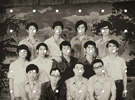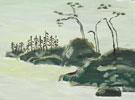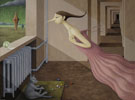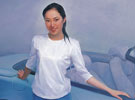“Chew” Thoughts on Series of Sprits of Tibet—Circumstances/ Experiences
My recognition of Qu Qianmei’s paintings is earlier than my acquaintance with her. That was on an international biennale. Afterwards she left Paris where she has resided for 26 years and returned to Beijing with her dreams and dedication for art. She is such a sensitive, intellectual and talented woman who knows how to live, what’s more she is also a straightforward, diligent and unique artist endowed with innovation. Having been to her studio for many times, I felt ashamed every time I saw her paintings since she has done something quite manlike.
Everyone who has been to Qu’s studio couldn’t help feeling surprised at her huge workload and her tremendous even overbearing creations. That’s why I feel ashamed of myself as being a devout pursuer of art. Her recently invented series of Sprits of Tibet—Circumstances/ Experiences mostly adopt high-temperature calcined kaolin as the main material. These works are vigorous and full of tension as well as the application of black endows them with calm and mysterious flavor. They are quite big in size while very thick channels are made for their frame, thus each piece of work is above hundreds of kilograms in weight. Whether from internal quality, quantity or from visual effects, they would be among the hall of fame in today’s abstract works and become an unavoidable topic among the circle of art.
In such an age that so called “artworks” overflow while “art” is deficient but faithless unvalued mediocre works which flatter captain are everywhere. However, Qu Qianmei works have brought us some comfort. Therefore, if there is a sense of crisis in today’s art world, the biggest crisis lies in the lack of the most potential power—force of thought and sincerity among the proliferation of art. When people are fully devoted themselves to art, they seldom sincerely think about its past, present and future. They rarely look for its internal process or initiatively advance to orient themselves with the art of this age between historical conceptions and aesthetic pursuit of the times. People who blind themselves with ambitious “creation” could not be enough since they make themselves painters but not artists. For that matter, Qu Qianmei is unquestionably a genuine artist. She sets an example for pious art pursuers. China needs such kind of artists!
Qu Qianmei has not only profound thoughts but also incomparable devotion and sincerity for human beings, history, nature and art. She gave up her comfortable living conditions and literate environment in France, she also dropped affectionate reunion with family to return alone for the quest of her artistic dreams and inner journey. Actually, this is a pilgrimage and return to her heart during her life course. Her creations interpret her style that her sincere transformation aims to attain and her depictions in no state possess all the beauty. They reveal a strong expression in epic depiction with simplicity. There are no tricks in her originality but her personal characteristics through candid style. They convey a kind of vivid emotional sincerity and inner concise thinking of external things. As for creation, she always pursues “the whole perfection” since the overall is a great feeling and it contains numerous partial perfections. Her works do not only mean her geographical return from West to East, from France to China but also a kind of spiritual recurrence from drifting to setting, from bound to free; moreover it is a return to painting itself, from the concrete to the abstract, from the concept to the purely emotional expression. This kind of return is a realm of life and Qu Qianmei represents it with her artistic creations. Her “presentation” or creation is based on her rational understanding of diachronism and temporal spirit in the developing laws of paintings as well as conflicted features of numerous emerging artistic trends of thought; it is also based on the background of mutual exclusion and fusion between Chinese and Western cultures as well as her deep comprehension of entire excellent traditions and cultures of human beings. Consequently, she organically combines her great cultural richness of content with her strong artistic characteristics to step with no hesitation into a remarkable level of contemporary art creation.
This also increases the artist’s own spiritual vision. However, her spiritual vision and her personal growth are closely related to her art, whether in life or art, Qu Qianmei always remains sincere and intelligent. She is releasing her potential energy—her artistic feelings and storage of thoughts. Her works are the most abstract form of emotions hidden in the dark. As the artist herself said, “Spirits of Tibet starts here. Accumulation and fascination of many years has turned into creative passion and hard work, and blended into the red clay on the plateau, integrated into images in my dreams, broken in its all fury…”
She is not willing to put too much of her own pursuits into contemporary art activities which have some distance with her thinking and artistic practices. She would rather walk farther with fewer utilitarian. She creates according to her own will rather than taking orders from others. Only trusting her own feelings and profound rational thinking, she seems more pure and self from the perspective of artist. Certainly, she seems more stylish. Frankly speaking, this might be only a section of her life course which is “a brief return and realm” and there is still a long way to go on the path of art. We do hope she would walk more stably, more steadily and more purely.
If there must be some “artistic conception”, for me it is that an artist should prove excellent art still exists and has its ample reasons to continue through his or her genuine creation. Qu Qianmei makes us more confident in the development of abstract art and life through her artistic practices. I think even though God has his will, art will never make its every pious pilgrim unworthy.
Li Lei










